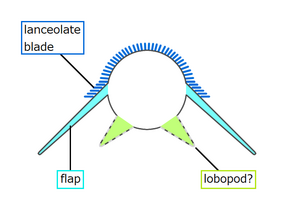
Lobopodians are members of the informal group Lobopodia, or the formally erected phylum Lobopoda Cavalier-Smith (1998). They are panarthropods with stubby legs called lobopods, a term which may also be used as a common name of this group as well. While the definition of lobopodians may differ between literatures, it usually refers to a group of soft-bodied, marine worm-like fossil panarthropods such as Aysheaia and Hallucigenia.

Opabinia regalis is an extinct, stem group arthropod found in the Middle Cambrian Burgess Shale Lagerstätte of British Columbia. Opabinia was a soft-bodied animal, measuring up to 7 cm in body length, and its segmented trunk had flaps along the sides and a fan-shaped tail. The head shows unusual features: five eyes, a mouth under the head and facing backwards, and a clawed proboscis that probably passed food to the mouth. Opabinia probably lived on the seafloor, using the proboscis to seek out small, soft food. Fewer than twenty good specimens have been described; 3 specimens of Opabinia are known from the Greater Phyllopod bed, where they constitute less than 0.1% of the community.

Yohoia is an extinct genus of megacheiran arthropod from the Cambrian period that has been found as fossils in the Burgess Shale formation of British Columbia, Canada. The type species, Yohoia tenuis, was described in 1912 by Walcott, who considered it an anostracan crustacean. 711 specimens of Yohoia are known from the Greater Phyllopod bed, where they comprise 1.35% of the community. In 2015, Conway Morris et al. reported another species, Y. utahana, from the Marjum Formation, Utah.
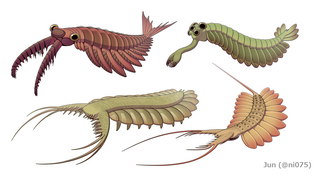
Dinocaridida is a proposed fossil taxon of basal arthropods that flourished in the Cambrian period with occasional Ordovician and Devonian records. Characterized by a pair of frontal appendages and series of body flaps, the name of Dinocaridids comes from Greek, "deinos" and "caris", referring to the suggested role of some of these members as the largest marine predators of their time. Dinocaridids are occasionally referred to as the 'AOPK group' by some literatures, as the group compose of Radiodonta, Opabiniidae, and the "gilled lobopodians" Pambdelurion and Kerygmachela. It is most likely paraphyletic, with Kerygmachela and Pambdelurion more basal than the clade compose of Opabiniidae, Radiodonta and other arthropods.

Anomalocaris is an extinct genus of radiodont, an order of early-diverging stem-group arthropods.
A number of assemblages bear fossil assemblages similar in character to that of the Burgess Shale. While many are also preserved in a similar fashion to the Burgess Shale, the term "Burgess Shale-type fauna" covers assemblages based on taxonomic criteria only.

The Wheeler Shale is a Cambrian (c. 507 Ma) fossil locality world-famous for prolific agnostid and Elrathia kingii trilobite remains and represents a Konzentrat-Lagerstätte. Varied soft bodied organisms are locally preserved, a fauna and preservation style normally associated with the more famous Burgess Shale. As such, the Wheeler Shale also represents a Konservat-Lagerstätten.
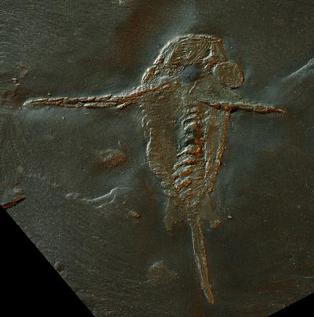
Schinderhannes bartelsi is a species of hurdiid radiodont (anomalocaridid) known from one specimen from the lower Devonian Hunsrück Slates. Its discovery was astonishing because previously, radiodonts were known only from exceptionally well-preserved fossil beds (Lagerstätten) from the Cambrian, 100 million years earlier.
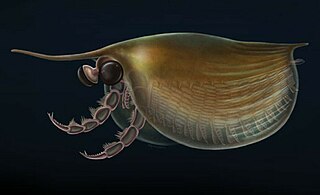
Isoxys is a genus of extinct bivalved Cambrian arthropod; the various species of which are thought to have been freely swimming predators. It had a pair of large spherical eyes, and two large frontal appendages used to grasp prey.

Radiodonta is an extinct order of stem-group arthropods that was successful worldwide during the Cambrian period. They may be referred to as radiodonts, radiodontans, radiodontids, anomalocarids, or anomalocaridids, although the last two originally refer to the family Anomalocarididae, which previously included all species of this order but is now restricted to only a few species. Radiodonts are distinguished by their distinctive frontal appendages, which are morphologically diverse and used for a variety of functions. Radiodonts included the earliest large predators known, but they also included sediment sifters and filter feeders. Some of the most famous species of radiodonts are the Cambrian taxa Anomalocaris canadensis, Hurdia victoria, Peytoia nathorsti, Titanokorys gainessii, Cambroraster falcatus and Amplectobelua symbrachiata, the Ordovician Aegirocassis benmoulai and the Devonian Schinderhannes bartelsi.

Hurdia is an extinct genus of hurdiid radiodont that lived 505 million years ago during the Cambrian Period. Fossils have been found in North America, China and the Czech Republic.

Stanleycaris is an extinct, monotypic genus of hurdiid radiodont from the middle Cambrian (Miaolingian). The type species is Stanleycaris hirpex. Stanleycaris was described from the Stephen Formation near the Stanley Glacier and Burgess Shale locality of Canada, as well as Wheeler Formation of United States. The genus was characterized by the rake-like frontal appendages with robust inner spines.
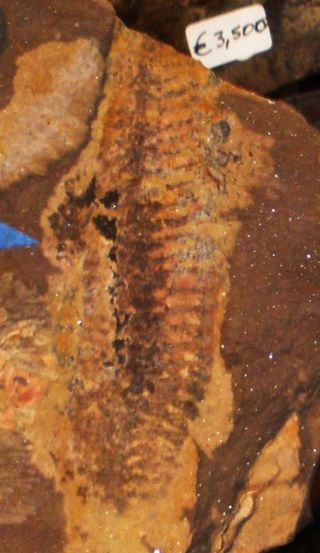
Myoscolex is an early animal species known from the Cambrian Emu Bay Shale in South Australia. It was interpreted as an annelid and some supports that theory, while it was also considered as an arthropod close to Opabinia, through other studies questions that interpretation. Myoscolex is the earliest known example of phosphotized muscle tissue, and as to which shows distinct annulation.

Opabiniidae is an extinct family of marine stem-arthropods. Its type and best-known genus is Opabinia. It also contains Utaurora. Opabiniids closely resemble radiodonts, but their frontal appendages were basally fused into a proboscis. Opabiniids also distinguishable from radiodonts by setal blades covering at least part of the body flaps and serrated caudal rami.

Amplectobeluidae is a clade of Cambrian radiodonts.

Aegirocassis is an extinct genus of giant radiodont arthropod belonging to the family Hurdiidae that lived 480 million years ago during the early Ordovician in the Fezouata Formation of Morocco. It is known by a single species, Aegirocassis benmoulai. Van Roy initiated scientific study of the fossil, the earliest known of a "giant" filter-feeder discovered to date. Aegirocassis is considered to have evolved from early predatory radiodonts. This animal is characterized by its long, forward facing head sclerite, and the endites on its frontal appendages that bore copious amounts of baleen-like auxiliary spines. This animal evolving filter-feeding traits was most likely a result of the Great Ordovician Biodiversification Event, when environmental changes caused a diversification of plankton, which in turn allowed for the evolution of new suspension feeding lifeforms. Alongside the closely related Pseudoangustidontus, an unnamed hurdiid from Wales, the middle Ordovician dinocaridid Mieridduryn, and the Devonian hurdiid Schinderhannes this radiodont is one of the few known dinocaridids known from post-Cambrian rocks.

Kylinxia is a genus of extinct arthropod described in 2020. It was described from six specimens discovered in Yu'anshan Formation in southern China. The specimens are assigned to one species Kylinxia zhangi. Dated to 518 million years, the fossils falls under the Cambrian period. Announcing the discovery on 4 November 2020 at a press conference, Zeng Han of the Nanjing Institute of Geology and Paleontology, said that the animal "bridges the evolutionary gap from Anomalocaris to true arthropods and forms a key ‘missing link’ in the origin of arthropods," which was "predicted by Darwin’s evolutionary theory." The same day the formal description was published in Nature.

Houcaris is a genus of tamisiocarididid radiodonts known from Cambrian Series 2 of China and the United States. It contains two species, Houcaris saron and Houcaris magnabasis, both of which were originally named as species of the related genus Anomalocaris. The genus Houcaris was established for the two species in 2021 and honors Hou Xianguang, who had discovered and named the type species Anomalocaris saron in 1995 along with his colleagues Jan Bergström and Per E. Ahlberg.
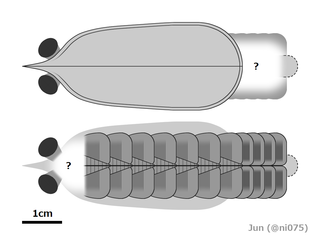
Erratus is an extinct genus of marine arthropod from the Cambrian of China. Its type and only species is Erratus sperare. Erratus is likely one of the most basal known arthropods, and its discovery has helped scientists understand the early evolution of arthropod trunk appendages. Some of the stem-arthropods like radiodonts did not have legs, instead they had flap like appendages that helped them swim. Erratus on the other hand had not only flaps but also a set of primitive legs. It also supported the theory that the gills of aquatic arthropods probably evolved into the wings and lungs of terrestrial arthropods later in the Paleozoic.
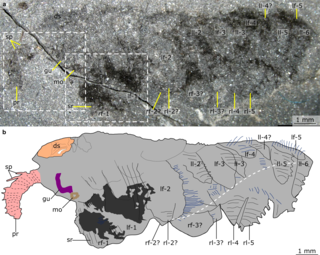
Mieridduryn is a genus of extinct dinocaridid arthropod that lived during the Middle Ordovician of what is now the United Kingdom. This animal was described in 2022 based on a singular fossil found in Castle Bank, a Burgess shale type lagerstätte located in the country of Wales. This animal's taxonomic affinities are somewhat unclear, but there are some hypotheses. One is that this animal represents a new grade of Stem-euarthropods that evolved features similar to the Cambrian aged opabiniids. Another is that if the features seen in Mieridduryn are convergent, and not homologous, to those seen in radiodonts, then this animal represents a late surviving opabiniid.




